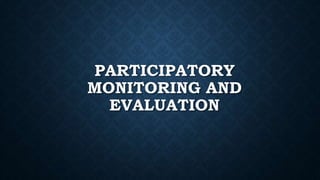
Participatory monitoring and evaluation.pptx
- 2. Monitoring refers to keeping track of the implementation of a project. It involves the study of the progress of an undertaking in relation to the agreed-upon schedule, resources, and performance indicators. Moreover, it identifies “lagging areas” that require intervention. Monitoring is also defined as the management function guiding the project towards its intended directions, and checking the performance of workers using predetermined plans and targets to ensure their timely completion.
- 3. Furthermore, monitoring is the implementation of effective internal controls that are generally built into daily operational activities. Along with other procedures, monitoring can be in any of the following forms: 1. Assessment of one’s daily operational activities 2. Utilization of internal audit personnel or other similar personnel who perform a wide range of functions 3. Correspondence with the third parties 4. Implementation of additional safeguards
- 4. Monitoring is a type of process performed while a project is being implemented. It aims to develop a project design in real time. The information gathered during the monitoring is used to make important changes in the project. As an interval activity, it provides constant feedback on the progress of a project. Example: the problems it encounters and the efficiency of its implementation
- 5. Evaluation is the study of the project outcome and the factors that led to such an outcome (e.g., changes in income, housing quality, benefits distribution, and cost- effectiveness), with the aim of improving the design of future project. Evaluation is, therefore, used in selection. Evaluation studies assess the extent to which a certain project can produce certain result and distribute benefits among different groups. It also includes a review of the overall cost-effectiveness of the project.
- 6. Monitoring and evaluation are neither expensive nor complicated. They do not require specialists or technicians. The complexity of these studies can be adapted to fit the needs of a program.
- 7. According to Luna and Bawagan (2009), monitoring is done during the implementation of a program to check it progress. The people’s participation and their candid feedback are important during this phase. Some guiding questions used for monitoring are as follows: 1. Was the target number of training participants achieved on time? 2. How does the actual number of training participants compare vis-à-vis the target number? 3. Were the required resources available?
- 8. Meanwhile, evaluation is identifying the effects and outcomes of a project. Conducting an evaluation at the end of a project or a few years after its implementation would involve the following questions: 1. What improvement of the people arose from the project? 2. Did the project improve the people?
- 9. Monitoring Outcomes Monitoring outputs has been a standard practice for a long time. However, it is imperative to ask, “In what way is a project beneficial to its target group?” and “What are the outcomes, results, and the impacts of a project?” These questions are often neglected because they are difficult to answer. However, confronting them is essential because the question of whether or not a project is beneficial will answer the question whether or not the purpose of the project fulfilled.
- 10. Monitoring Accountability It has been proven that the continuous monitoring and recording of information regarding the outcome and impact of a project are crucial in project steering because they fine-tune activities, thereby, maximizing results.
- 11. Providers are expected to have their projects constantly monitored and evaluated by the project implementers and outside experts. Constant monitoring and evaluation provide more immediate feedback and facilitate learning. Having an external evaluator is considered to be desirable and very helpful in bringing out insights coming from an independent and objective perspective.
- 12. Evaluation is process of systematically assessing the design, implementation, and effect of certain programs, policies or projects. In the past, the evaluation process employed research methods used in the social sciences to determine the impact of public programs and policies. Modern evaluation has its roots in the 1960s, when government policy makers wanted to know the impact of new public programs.
- 13. Participatory Evaluation Participatory evaluation involves the active participation of the stakeholders in assessing the implementation and impact of a project. The people concerned present their own analyses. Here are some techniques that can be used in participatory evaluation: 1. Forming a focus group 2. Spearheading participatory action research 3. Drawing metaphor 4. Constructing tables
- 14. 1. Forming a focus group Focus groups are groups of people who ask open-ended questions. The members are allowed to say anything and be heard. The facilitator will summarize the ideas presented in an overall evaluation.
- 15. 2. Spearheading participatory action research Participatory action research involves asking inputs from both the researchers and the participants in determining issues and concerns.
- 16. 3. Drawing metaphors This method is useful for participants who are shy, timid, or reluctant to voice out their comments or suggestions. In this strategy, the participants answer evaluative questions by drawing metaphors or word description.
- 17. 4. Constructing tables In this method, the participants construct a table or framework that includes the following areas: objectives/goals, activities, time frames, strategies, and outputs of the project. They are then asked to interpret their project table as an evaluation matrix.
- 18. Reflection: 1. If you were given a chance to monitor a project, what strategies would you use or apply? 2. Why is there a need to conduct monitoring and evaluation, especially renewing projects? 3. What are the purpose of monitoring and evaluating a project?
Editor's Notes
- vis-à-vis- means in relation to